by Gary Powell
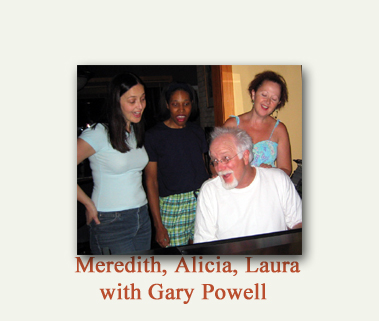
Last night was just plain fun recording Meredith McCall, Alicia Jones and Laura Benedict. All three singers have been working here at Powell Studio Productions for decades and will have their rich histories documented here soon. Together we arranged the parts for two songs on the spot with the girls in front of the mics. With no notes written, we call this a “head-chart”. I had worked out some ideas before beginning the session, but nothing was written down. It’s an exciting way to create group vocals. I have a midi keyboard at the mixing console and together we create the voicings (how the notes of each chord are stacked and who sings which one) and then the singers deliver the performance on the spot. It’s dazzling how quickly this process goes forward with experienced and talented singers with studio experience.
The first song was a remake of “Rocking Around the Christmas Tree”. Laura Benedict reminiscently sang the lead of Brenda Lee’s signature performance. Laura then stayed to sing the background vocals with Meredith and Alicia. We decided not to reproduce the “choir-like” squaresville vocals of the original. We went with a three-part texture that was sung with a more typically modern pop vocal sound.
The second song was one of my new Christmas songs for children. The arranging technique became more interesting as we progressed through this theatrical piece. In the song’s prologue the BG vocals were used to accentuate the interesting harmonic changes (IE, the single line melody was sure to include the augmented 5th of the augmented five chord.)
It made for a nice etherial element emphasizing the harmonization choices. Next the girls picked up on the fun bass guitar part of the choruses by doubling the bass two octaves up with their best upright bass thumping vocal sound. Next, we found a few lines of the lead vocal that we harmonized in a single part a third above. At the end of the song we sang in three parts for the first time to support the big ending. None of the three parts doubled the lead vocal as we decided to keep the voicing tight and underneath the lead melody line.
We cut all three girls using a mid-side micing technique with two AKG-414’s running through Mark McQuilken’s RNP (Really Nice Preamp). I have found this mic configuration only works when using very experienced singers who can manage to learn their part on the spot, deliver a perfectly in-tune performance and “mix” themselves as it all goes down. These skills can never be taken for granted just because someone is an awesome singer. It’s something entirely different from being a solo performer.
Thanks you guys for a really fun night.
by Gary Powell.Â
Session Date: June 3, 2005 / 7pm-12am
I have worked on four albums previously as Kurt Van Sickle’s choral arranger and vocal recording producer. Kurt is a leader in the meditational music field and writes beautiful melodies. In attendance at the session was Chet Himes, Kurt’s recording engineer. I engineer most of my own sessions, but having Chet present lended the session a set of outstanding ears and engineering talent. We recorded five men and five women simultaneously using a mid/side microphone configuration with a pair of AKG 414-TL’s (that Chet brought) running through a Drawmer 1960 Mic-Pre.
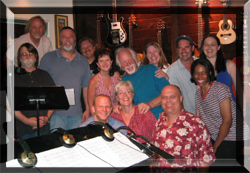
The singers pictured above are: Meredith McCall, Alicia Jones, Susan Lincoln, Rebecca Schoolar, Laura Benedict, Larry Seyer, Jerome Schoolar, Scott Kripple, Craig Toungate and John White. Most of these singers have been recording in my studio for more than 10 years and some as many as 20 years. My compliments and thanks to everyone present for their hard work, talent and wonderful attitudes. Also pictured are Kurt Van Sickle, Chet Himes and Gary Powell.
by Gary Powell.Â
Session Date: June 3, 2005 / 7pm-12am
I have worked on four albums previously as Kurt Van Sickle’s choral arranger and vocal recording producer. Kurt is a leader in the meditational music field and writes beautiful melodies. In attendance at the session was Chet Himes, Kurt’s recording engineer. I engineer most of my own sessions, but having Chet present lended the session a set of outstanding ears and engineering talent. We recorded five men and five women simultaneously using a mid/side microphone configuration with a pair of AKG 414-TL’s (that Chet brought) running through a Drawmer 1960 Mic-Pre.

The singers pictured above are: Meredith McCall, Alicia Jones, Susan Lincoln, Rebecca Schoolar, Laura Benedict, Larry Seyer, Jerome Schoolar, Scott Kripple, Craig Toungate and John White. Most of these singers have been recording in my studio for more than 10 years and some as many as 20 years. My compliments and thanks to everyone present for their hard work, talent and wonderful attitudes. Also pictured are Kurt Van Sickle, Chet Himes and Gary Powell.
by Gary Powell
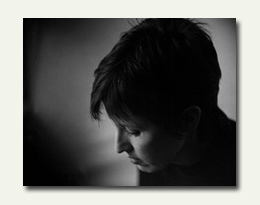 Today we recorded the final vocal for Helen Darling’s song, “Mistake” co-written with Gary Burr.
Today we recorded the final vocal for Helen Darling’s song, “Mistake” co-written with Gary Burr.
I cut Helen with a Rode NTV through Mark McQuilken’s RNP (Really Nice Preamp). This combination of mic/mic-pre is warm and wonderful for Helen’s voice with no sibilance at all. With Helen, there was no need to compile the vocal from different takes. We have a conversation about the performance she is choosing and with a very few punches we’re done. We recorded a three/four part background vocal texture in the bridge with cascading, major 2nds added to each chord change. It offers a beautiful blue-grass voicing for those chords. None of it was parallel to the lead vocal, which we both loved. Helen has a wonderfully quick ear and is a total pro (and fun) in the studio. Thanks, babe.
by Gary Powell
 Today we recorded the final vocal for Helen Darling’s song, “Mistake” co-written with Gary Burr.
Today we recorded the final vocal for Helen Darling’s song, “Mistake” co-written with Gary Burr.
I cut Helen with a Rode NTV through Mark McQuilken’s RNP (Really Nice Preamp). This combination of mic/mic-pre is warm and wonderful for Helen’s voice with no sibilance at all. With Helen, there was no need to compile the vocal from different takes. We have a conversation about the performance she is choosing and with a very few punches we’re done. We recorded a three/four part background vocal texture in the bridge with cascading, major 2nds added to each chord change. It offers a beautiful blue-grass voicing for those chords. None of it was parallel to the lead vocal, which we both loved. Helen has a wonderfully quick ear and is a total pro (and fun) in the studio. Thanks, babe.
by Gary Powell, ProducerÂ
Helen Darling writer of “Bring on the Rain” (performed by Jo Dee Messina) is in the studio today recording a publishing demo for her new song, “Mistake” co-written with Gary Burr. Helen and I have been working together in the studio since 1985! The session was recorded in Digital Performer 4.5 using GigaStudio3 with Larry Seyer’s Acoustic Bass Library. Larry is also playing the guitar, mandolin and slide guitar parts in person. Larry and I have been working together in the studio since 1978! The guitars are being cut with a stereo pair (AT4033) through Mark McQuilken’s RNP
(Really Nice Preamp).
This combination of mic and pre makes for a beautifully crisp guitar sound – no EQ needed. These are my old and good friends to say the least. And yes, Helen, we know you are 1.5 versions younger than Larry and me! Nice day in the studio.
by Gary Powell, ProducerÂ
Helen Darling writer of “Bring on the Rain” (performed by Jo Dee Messina) is in the studio today recording a publishing demo for her new song, “Mistake” co-written with Gary Burr. Helen and I have been working together in the studio since 1985! The session was recorded in Digital Performer 4.5 using GigaStudio3 with Larry Seyer’s Acoustic Bass Library. Larry is also playing the guitar, mandolin and slide guitar parts in person. Larry and I have been working together in the studio since 1978! The guitars are being cut with a stereo pair (AT4033) through Mark McQuilken’s RNP
(Really Nice Preamp).
This combination of mic and pre makes for a beautifully crisp guitar sound – no EQ needed. These are my old and good friends to say the least. And yes, Helen, we know you are 1.5 versions younger than Larry and me! Nice day in the studio.
by Gary Powell
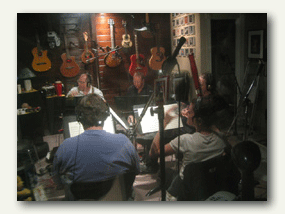
Ensemble: Wild Basin Winds
Recording Dates: 4/10,11,13/2005
Click Here for Session Photos
The woodwind quintet ensemble (flute, clarinet, oboe, horn, bassoon) creates a unique challenge in the recording studio. The flute speaks upward, the clarinet speaks downward, the oboe speaks downward, the horn speaks to the rear and the bassoon speaks from the middle of the instument for its middle range and speaks upward for its lower register. Sonically, in my space the horn’s warm sound permeated the room and the oboe’s lanquid sound bleeds into all the microphones. The accepted method is to record this ensemble with the classical setup of a stereo pair about 10 feet in front of the group. This traditional setup asks a lot from the room to do the mixing for you. Fine if the room sounds good, but this will not produce a sound with the kind of presence that I wanted. A quick call to engineer guru, Larry Seyer, helped me try both setups described below. Wild Basin Winds was recording Christmas arrangements by Gary Slechta. Half of these beautifully written charts were classical in nature and the other half were written in a very creative swing big band style. Amazingly enough, these players were adept in both styles.
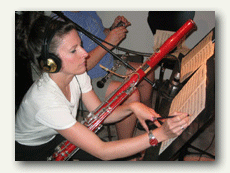
Classical Setup: Two stereo pair. The first pair was parallel with the foward most players (oboe/flute) and about 5 feet above. The second pair was at the same height, but about 3 feet behind the rear most player (horn).
Swing Band Setup: Each player was individually mic’d in accordanced with the characteristics of each instrument mentioned above. FLUTE: (AKG414) placed 3 feet above. CLARINET: (AKG414) 1 foot below the bell. HORN: (Audio Technica 4033a) 3 feet behind the bell. BASSOON: (Audix i5) 1 foot directed mid-instrument. OBOE: (Rode NTV) 1 foot below the bell.
Using two different setups worked well because of the dual nature of Gary Slechta’s charts. However, if I had it to do over, I would choose the Swing Band setup with the invidual microphones with its ability to sculpt the mix. I also prefer the close mic’d sound, even for classical ensembles. This preference is not widely shared, however.
We also optioned many microphones and all seemed happy with the final choices listed above. My thanks to Mathew Krejci (Flute), Gary Sperl (Clarinet), Tom Hale (Horn), Daris Word Hale (Bassoon), Ian Davidson (Oboe) and Gary Slechta (Arranger) for three fun, musically inspiring days with outstanding musicians and musicianship.
by Gary Powell

Ensemble: Wild Basin Winds
Recording Dates: 4/10,11,13/2005
Click Here for Session Photos
The woodwind quintet ensemble (flute, clarinet, oboe, horn, bassoon) creates a unique challenge in the recording studio. The flute speaks upward, the clarinet speaks downward, the oboe speaks downward, the horn speaks to the rear and the bassoon speaks from the middle of the instument for its middle range and speaks upward for its lower register. Sonically, in my space the horn’s warm sound permeated the room and the oboe’s lanquid sound bleeds into all the microphones. The accepted method is to record this ensemble with the classical setup of a stereo pair about 10 feet in front of the group. This traditional setup asks a lot from the room to do the mixing for you. Fine if the room sounds good, but this will not produce a sound with the kind of presence that I wanted. A quick call to engineer guru, Larry Seyer, helped me try both setups described below. Wild Basin Winds was recording Christmas arrangements by Gary Slechta. Half of these beautifully written charts were classical in nature and the other half were written in a very creative swing big band style. Amazingly enough, these players were adept in both styles.

Classical Setup: Two stereo pair. The first pair was parallel with the foward most players (oboe/flute) and about 5 feet above. The second pair was at the same height, but about 3 feet behind the rear most player (horn).
Swing Band Setup: Each player was individually mic’d in accordanced with the characteristics of each instrument mentioned above. FLUTE: (AKG414) placed 3 feet above. CLARINET: (AKG414) 1 foot below the bell. HORN: (Audio Technica 4033a) 3 feet behind the bell. BASSOON: (Audix i5) 1 foot directed mid-instrument. OBOE: (Rode NTV) 1 foot below the bell.
Using two different setups worked well because of the dual nature of Gary Slechta’s charts. However, if I had it to do over, I would choose the Swing Band setup with the invidual microphones with its ability to sculpt the mix. I also prefer the close mic’d sound, even for classical ensembles. This preference is not widely shared, however.
We also optioned many microphones and all seemed happy with the final choices listed above. My thanks to Mathew Krejci (Flute), Gary Sperl (Clarinet), Tom Hale (Horn), Daris Word Hale (Bassoon), Ian Davidson (Oboe) and Gary Slechta (Arranger) for three fun, musically inspiring days with outstanding musicians and musicianship.


 Today we recorded the final vocal for
Today we recorded the final vocal for 
